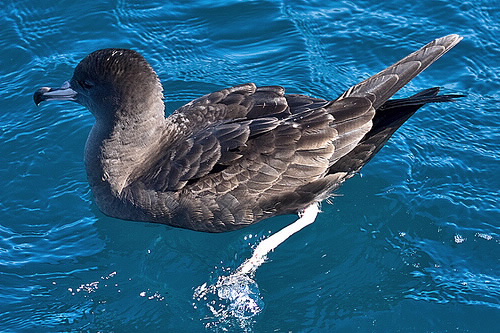Plastic pollution is finding its way into the tissues of marine wildlife. Although many environmental risks of plastic have long been known, analysis by ANSTO has detected chemicals from plastic pollution in the feathers of seabirds. However, this research is also giving clues to how to manage the problem.
 |
| Image: Flesh-Footed Shearwater ajmatthehiddenhouse / Foter |
The work is a collaboration between Richard Banati, a biomedical scientist at ANSTO LifeSciences, and Monash University conservation biologist Jennifer Lavers.
They analysed the elemental composition of plastic items collected from the stomachs of flesh-footed shearwaters. These were then compared with the atomic elements in the feathers from birds of the same species—some that had eaten plastics and some that had not.
The plastic and feather samples were analysed first at the Australian Synchrotron light source in Melbourne and then at the country’s only operating nuclear reactor, the ANSTO Open-Pool Australian Lightwater (OPAL) research reactor in Sydney. There they were subjected to neutron activation, in which atoms are bombarded with neutrons to make them slightly radioactive.
Each element is then identified by its distinctive gamma-ray spectrum, giving measurements of composition so accurate they’ve been compared with determining the vintage of a single glass of red wine spilled into Sydney Harbour.
This produced some interesting findings, such as a regular distribution pattern of elements in each feather—much like the rings of trees. It also confirmed the researchers’ initial suspicions: trace elements from plastic were found in the feathers of birds that had eaten it.
The health effects of these elements aren’t well understood, but their presence in tissues shows the complexity of the pollution problem. Contrary to expectations, plastics that degrade in the environment are not necessarily safer for wildlife, as the increased surface area as they break down can exacerbate the release of toxins like cadmium and mercury.
“A traditional approach to environmental management has been ‘the solution to pollution is dilution’,” says Richard Banati. “However, many fear that uncontrolled mass plastic consumption, together with increased degradability of plastics, may actually lead to a steady increase of hazardous contaminants in the environment which would be difficult to reverse.”
However, the researchers stress that their aim is not to demonise plastic, but rather to better understand it at an atomic level.
Richard Banati, who has used radioactive elements in pharmaceutical research to track a drug’s progress through the body, points to the intriguing possibility that manufacturers, too, could add an isotopic signature of non-radioactive trace elements to plastics to trace their lifecycle.
A thought experiment illustrates the sensitivity of the analytical nuclear techniques used at ANSTO. A combination of non-abundant elements together with a small amount of precious metal like gold—as little as 10 milligrams per tonne—would be detectable by ANSTO’s instruments and could be in principle used to trace the litter’s original source.
“Plastics will always have a place in our world,” says Richard. “But we need to be mindful that a ‘single-use’ throw away item may disappear from sight but in one form or another remains in the environment for a very long time”.
ANSTO’s Institute for Environmental Research already uses the ability to distinguish naturally occurring isotopes to follow the movement of groundwater and rainwater into the hydrologic cycle, and to examine other human impacts on the climate and environment.
These activities sit alongside ANSTO’s long-standing roles in medical research—contributing to new ways of treating conditions like Alzheimer’s and Parkinson’s diseases, as well as producing 85 per cent of the nuclear medicines used in Australian hospitals—and materials engineering, such as the development of Synroc—tailored ceramic forms for locking up high-level radioactive waste.
Read the publication here.


